March 9, 2018
Victor picked us up at the hotel at 10:30, and we headed towards the Plaza de la Constitución, the main zocolo, or public square, of the city. I've circled a few of the places we went on the map below just to show how condensed the sites are. The Plaza is #2.
On our way to the Plaza, we stopped at the Palacio Bellas Artes, or Fine Arts Palace (#1 on the map), which is where the famous Ballet Folklorico performs. Built between 1904 and 1934, it has an Art Nouveau exterior . . .
. . . and an Art Deco interior. Here is the inside of the dome . . .
. . . and a view of the main lobby:
 |
| Photo from here |
I think this installation was just outside the Palacio de las Artes, but I can't remember what it was about. Perhaps it is commentary on the conquest of Mexico or the slave trade?
We also took a peak inside the Palacio de Correos, or main post office, which was just across the street. Victor told us it had served as the model for the Department of Family Reunions in the Disney movie Coco. Does it look familiar?
 |
| Photo borrowed from here |
Next on the itinerary was the Convento de San Francisco, the headquarters of the first Franciscans to come to Mexico by direction of the Pope. It was built on the site of the Aztec emperor Moctezuma's zoo. This church is where the funeral mass for Hernando Cortéz was held when word came that he had died in Central America. Because of foundation issues, however, the current building is the third church built on the site. Still, it is over 300 years old. Over the years, parts of what was once a huge church were gradually torn down to make way for roads and new buildings.
The main altar and the "Mary Chapel" are beautiful:
Other than the altar and the chapel, the architecture is relatively simple, but the walls are adorned with large paintings depicting important events from the life of St. Francis. It's hard to see beyond that chandelier, but here is Francis at the foot of the cross worshiping Jesus:
St. Francis teaching the villagers:
I'm not sure, but I think this depicts St. Francis being carried up to heaven:
I loved the Baroque interior, which felt European and yet still very Mexican.
Located on a narrow street and surrounded by tall buildings, it was difficult to get a good look at the San Felipe Neri Church, but Victor know the perfect viewing point--the rooftop of the Museo del Estanquillo just across the street:
We'd been wandering around it, but now it was time to enter the Plaza de la Constitución.
It seems appropriate that our first stop was the location of the Aztec palace. Before the conquistadors arrived and then built their own churches and palaces on this same site, Moctezuma was the emperor of a vast, wealthy kingdom. In 2008, one of the nearby buildings was being renovated, and during that process the machinery ran into pieces of an ancient building that came to be known as Casas Nuevas, or New Houses (to set it apart from palaces built by Moctemzuma's predecessors).
The archaeological work on the site has gone slowly, but much has been learned about the Aztec city that once spread out over this area.
Large topographic maps show the location of various sites.
The city of Tenochtitlan, as it was called by the Aztecs, was entered via wide causeways built on the Lake Texcoco. People traveled within the city on irrigation channels and canals.
This diorama depicts the most sacred space within Tenochtitlan, a platform that held political and religious buildings. Historical records say there were 78 temples here, all arranged according to a cosmological plan. The main temple, or Templo Mayor (#5 on map) is the largest building in this diorama.
The National Cathedral is also very close:
Modern descendants of the Aztecs are still laying claim to this area--even if it is just to entertain tourists.
We walked from Moctezuma's Palace to the National Palace (#4 on the map), the seat of Mexico's federal government. Supposedly some of the building materials for this structure were taken from the demolished Aztec Palace.
Walking through the arches into the center courtyard brought back a flood of memories of myself almost forty years earlier in the same place.
The two photos below were taken in 1978:
. . . and we took in 2018 from just about the same spot:
I remember well my first view of the panoramic History of Mexico mural by Diego Rivera inside the building. It is a stunning, breathtaking piece of art. When I came back the next year on a university program, I attended lectures on Mexico's history in front of these murals, which consist for four main sections painted by Rivera between 1929 and 1935. Some are as large as 30' x 230'.
That must be Moctezuma in the chair. Behind him is El Templo Mayor.
Note the huge city in the background.
Moctezuma is gazing at a beautiful woman who looks suspiciously like FRIDA! She's lifting her skirt to show her legs--playing the part of the prostitute. Frida and Diego's on-again off-again relationship must have been in one of its off periods when he painted this.
Fabric dyers:
Craftsmen:
A dentist (No, thank you!):
Cacao pickers (Yes, thank you!):
Farm animals:
The marketplace:
Uh oh. Look who showed up. That sickly, weirdly proportioned, ogre-like man is Hernán Cortéz, who arrived in Veracruz, Mexico, in April 1519.
Here he is again:
The invasion begins:
Rivera clearly didn't appreciate the Spaniards' treatment of the indigenous people.
Then the invaders' descendants fought for and achieved their own independence.
Yep, that's Karl Marx ("Carlos Marx") on top, looking like a new Moses leading his people to the Promised Land. Rivera was a big fan of Marx. By the way, can you also find Frida in here?
She's down at the bottom. This must have been painted during their on-again period.
Everything else in the National Palace pales by comparison to this monumental work, but here are a few more pictures anyway.
An all-seeing eye:
A throne?
The exit!
Making our way around the zocolo, we made a quick stop at Santa Teresa la Antigua, a former convent that is now an art center. The current structure is a 1813 reconstruction of the original 1684 church.
The cupola over the convent area:
The cupola of the chapel is lined with stained glass windows.
The most important cathedral in this area is the Metropolitan Cathedral of the Assumption of the Most Blessed Virgin Mary into Heaven (#3 on the map), the seat of the Catholic archdiocese of Mexico. This huge church was built on top of what used to be the sacred buildings of the Aztecs, a common practice of the conquerors. What a way to show dominance! It was built in sections, starting in 1573, about 50 years after the conquest. The final section was added 240 years after the first in 1813.
Several of the sections are very distinct and were easily identified as we walked around the church.
The interior is about as grandiose and ornate as it gets.
The altar looks strangely modern in the rococo surroundings.
However, this is what is behind that simple altar.
On our way out we stopped to pay our respects to Pope John Paul II, quietly watching over his Mexican flock.
The statue has a nice likeness of his cheerful face.
However, there are two surprises. First, it is a little difficult to see, but the back of the Pope's cape is covered with keys, which I assume refer to his authority as the successor to Peter.
What is even more intriguing than the keys is what comprises his torso:
Where your heart is, there will be your treasure also, right?






























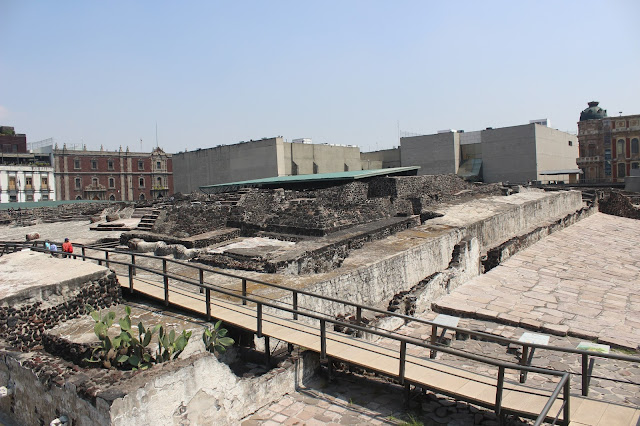








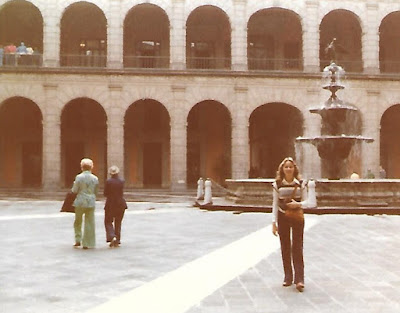























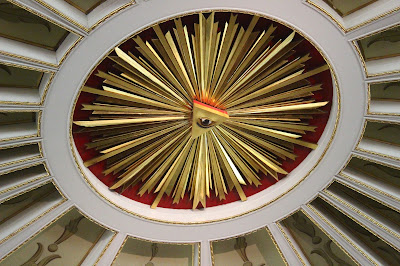






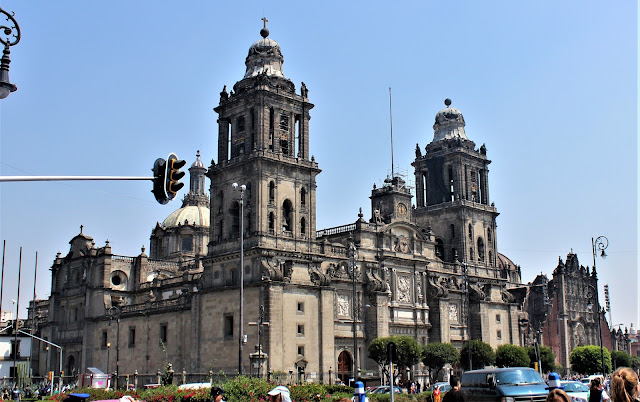













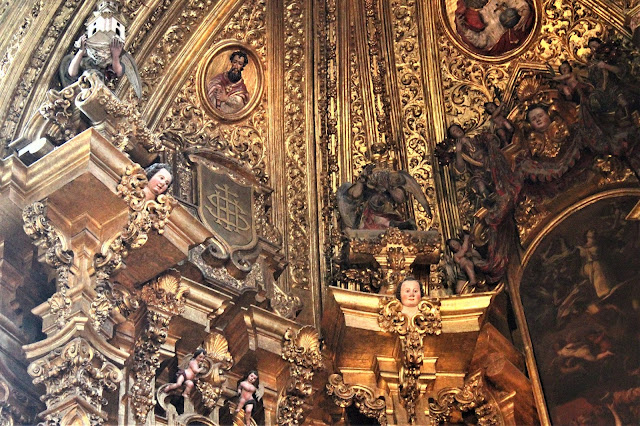











The black christ has an interesting story to it. It used to be in the first altar to the right when you walked in the cathedral. Legend has it one of the shop keepers got poisoned and he could not get all the way to the main altar. All he could do was get to the small side altar and he fainted. While he was falling he touched the feet of the statue and the statue turned black and the shop keeper was cured. The feet got touched so much they have since moved that cross and now only let people touch it during special ceremonies.
ReplyDeleteGreat story, John! I hope you will let me know if I make any obvious errors so that I can fix them. Please continue to add details! This is your territory!
DeleteWow, what a treasure trove of historical gems. I'd forgotten much of this. Mexico City is a tourism treat and I can't believe it took me so long to go.
ReplyDeleteThe lesson here is listen to your wife.
Delete